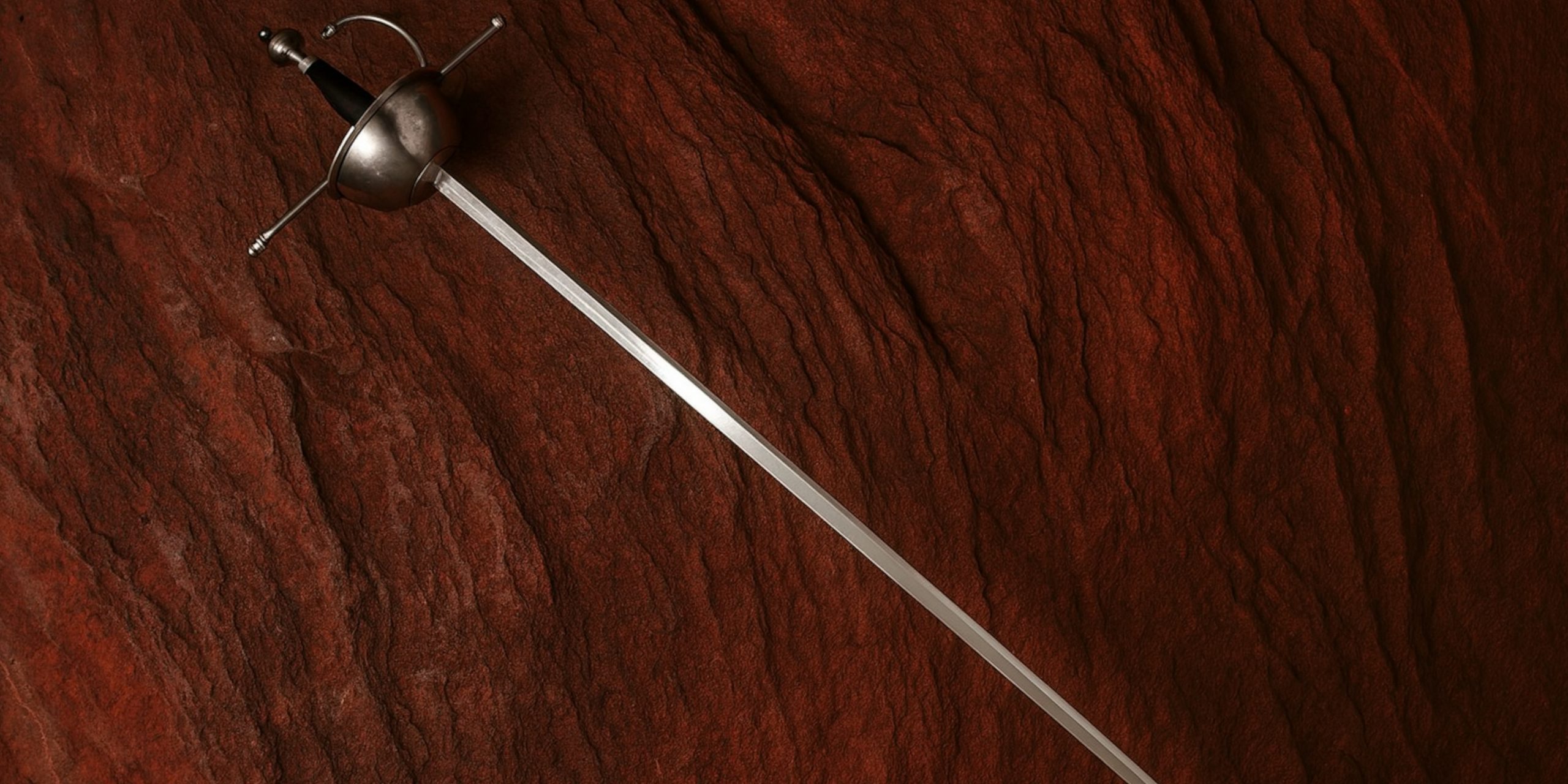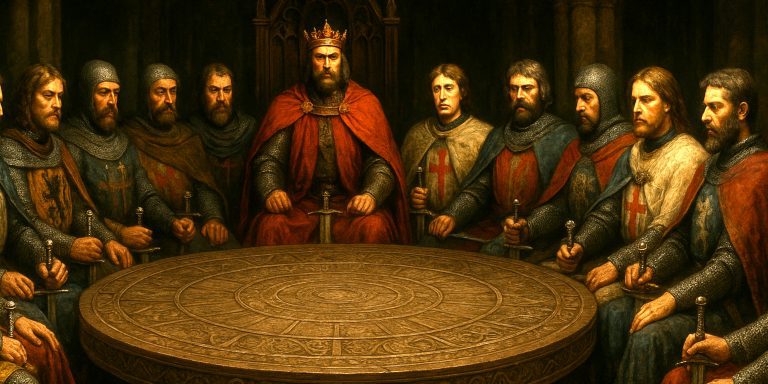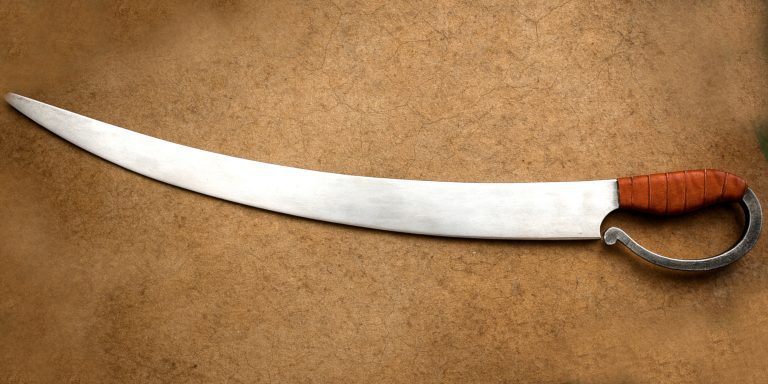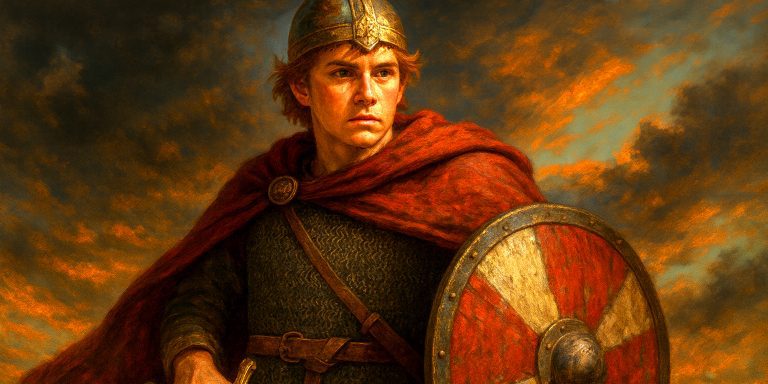
The espada ropera, often called the “dress sword,” emerged in 16th-century Spain as both a weapon and a fashion statement. Unlike the heavy battlefield swords of earlier centuries, this weapon was refined, elegant, and tailored to the urban duellist. It symbolised the rise of the gentleman-soldier, where social status and skill at arms walked hand in hand.
Its purpose was not purely for war but for personal defence and honour, making it a crucial link in the evolution from medieval longswords to the rapier and smallsword.
Specification
| Aspect | Detail |
|---|---|
| Type | Civilian sword (duelling and self-defence) |
| Origin | Spain, early 16th century |
| Length | Typically 110–130 cm overall |
| Blade length | Around 95–110 cm |
| Blade type | Straight, narrow, double-edged (early examples) or single-edged tapering to a fine point |
| Hilt | Complex swept-hilt with protective loops and guards |
| Weight | 1–1.3 kg on average |
| Balance | Forward but well distributed for thrusting control |
| Primary use | Civilian duelling, self-defence, and status display |
| Materials | High-carbon steel blade, brass or iron guard, wire-wrapped grip (often silver or gold gilt) |
History and Evolution
The espada ropera was born during the Spanish Renaissance, when nobles and soldiers returning from campaigns needed a sword suitable for civilian wear. Armour was falling out of favour, cities were safer, and swordsmanship was becoming more of an art than a necessity.
- Early 1500s: The sword evolved from the side sword (spada da lato) used in Italy. The Spanish version featured more intricate hilts for better hand protection and decorative flourish.
- Mid-1500s: As Spanish influence spread across Europe, so did the fashion for the ropera. Swordsmanship schools (escuelas de destreza) codified fencing methods that relied on geometry and precision rather than brute strength.
- Late 1500s–1600s: The blade grew longer and narrower, evolving into what we now call the rapier. The ropera remained distinct for its broader blade and hybrid design, capable of both cut and thrust.
- 1700s: It gradually gave way to the smallsword, a lighter, purely thrusting weapon that dominated the Age of Enlightenment.
Advantages
- Elegant versatility: Effective for both cutting and thrusting, unlike later duelling swords.
- High status symbol: Worn by nobles and officers as part of their attire.
- Superior craftsmanship: Spanish smiths were renowned for pattern-welded and Toledo steel blades.
- Improved hand protection: The swept-hilt design offered defence without bulk.
- Balance and finesse: Allowed quick, controlled strikes ideal for urban duels.
Disadvantages
- Unsuitable for heavy armour: Its light construction was poor against plate defences.
- Limited battlefield use: Designed for civilian combat, not large-scale warfare.
- Fragility in prolonged combat: The slender point could bend or snap under stress.
- Expensive to produce: Fine craftsmanship made it costly compared to military swords.
Comparison with Similar Weapons
| Weapon | Origin | Blade Type | Primary Use | Key Difference |
|---|---|---|---|---|
| Side Sword | Italy | Broader, double-edged | Military and civilian | Heavier and shorter than the ropera |
| Rapier | Spain / Italy | Long, narrow | Duelling | Lighter, pure thrusting weapon |
| Smallsword | France / England | Very narrow | Court wear and fencing | More decorative, less practical |
| Longsword | Europe | Broad, double-edged | Battlefield | Two-handed and armoured combat use |
| Basket-Hilt Broadsword | Britain / Scotland | Broad cutting blade | Infantry / cavalry | Focused on cuts, not thrusts |
Legacy
The espada ropera stands at the crossroads between medieval chivalry and Renaissance refinement. It symbolised the emergence of the gentleman as warrior-scholar, where mastery of the blade reflected intellect as much as courage.
The Spanish school of fencing, La Verdadera Destreza, influenced European swordplay for centuries. Even modern fencing owes part of its lineage to the geometric principles and stance developed around this elegant weapon.
In art and literature, the ropera appears as the mark of a true caballero. It was the weapon of duellists, poets, and explorers, from Madrid to the New World.
Where to See the Espada Ropera
- Museo del Ejército, Toledo (Spain) – Houses several pristine examples from the 16th and 17th centuries.
- Museo Arqueológico Nacional, Madrid – Contains ornate roperas with gilt hilts and Toledo blades.
- Wallace Collection, London – Features a collection of European civilian swords including early rapiers.
- Metropolitan Museum of Art, New York – Displays fine espadas roperas from Spanish workshops.
Collector’s Guide
Market Overview
- Authentic espadas roperas are rare and highly sought after due to their artistic and historical value.
- Blades marked “Toledo” command premium prices.
- Provenance, decoration, and intact hilt structures dramatically affect value.
Typical Auction Prices
| Condition | Period | Estimated Value (GBP) |
|---|---|---|
| Museum-grade (ornate Toledo blade) | 1550–1600 | £20,000–£40,000 |
| Well-preserved example | 1600–1650 | £8,000–£18,000 |
| Partial or restored | 17th century | £3,000–£7,000 |
| Replica or decorative | Modern | £200–£800 |
Buying Tips
- Verify authenticity through metallurgy testing and hilt design.
- Beware of 19th-century romantic reproductions.
- Prefer auction houses specialising in arms and armour such as Bonhams, Hermann Historica, or Czerny’s.
The Seven Swords Takeaway
The espada ropera represents the elegance and precision of Spain’s Golden Age, when the sword became as much a part of a man’s intellect as his attire. It bridged the brutal battlefields of the Middle Ages with the refined duelling culture of the Renaissance. Whether admired in a museum or held in a collector’s hand, it remains a testament to artistry, status, and the subtle science of defence.



